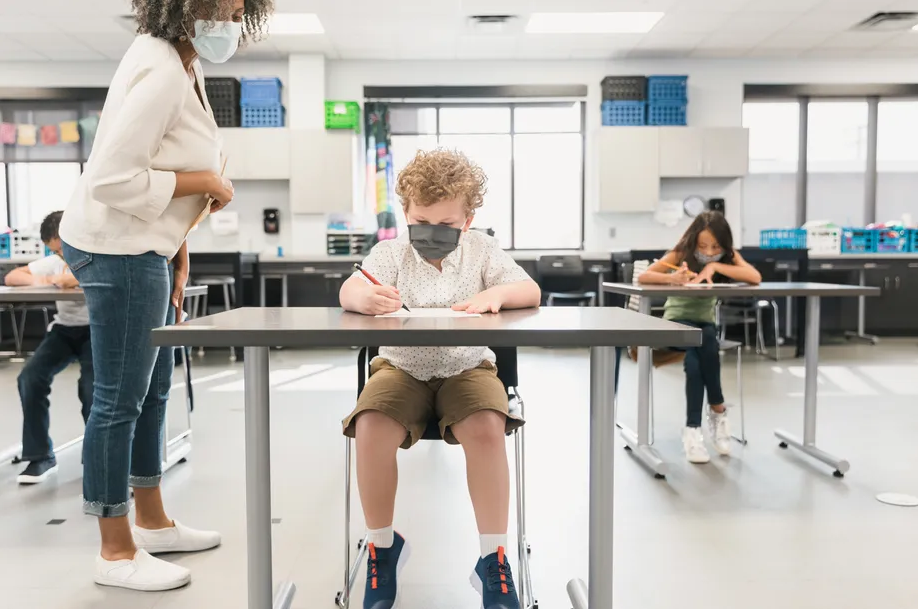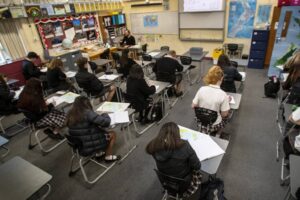Colorado students lost ground during year of disrupted learning
9 min read
Colorado students’ performance on state standardized tests declined across the board after a pandemic-disrupted school year, with larger drops for Hispanic students and those from low-income families. The test results provide the first statewide picture of student learning since 2019, as tests were canceled in 2020.
Data released Thursday shows that far fewer students took the tests, and those who did performed at levels last seen five to six years ago. Student performance fell more in math than in literacy, a trend that matches national patterns, with the drops particularly pronounced in middle school. Just 29.5% of eighth-graders who took the test met or exceeded grade level expectations, a decline of 7.4 percentage points from 2019.
High school juniors, though, did slightly better on the SAT than their counterparts in 2019.
The tests administered in spring 2021 were significantly scaled back compared to 2019, and test participation plummeted, particularly in populous Denver metro area districts. That makes it difficult to draw firm conclusions, assessment experts said. But state education officials believe the results would have been even lower if more students participated. Unlike in past years, the test results will not be used to evaluate teachers or to rate schools and districts. The school accountability system is on pause.
Colorado Education Commissioner Katy Anthes said the results should create a sense of urgency around learning.
“These test results give us sobering data that confirm just how hard last year was with school closures, class quarantines, and remote learning,” Anthes said in a statement. “As students return to school, it is extremely clear that we must accelerate learning more than we have done historically. If we just go back to doing what we have done before, we will not be successful.”
Colorado is in the process of finalizing its plans for spending federal relief dollars, and Anthes told the State Board of Education test results can help inform those plans.
“This is a once in a generation opportunity to support our students, and perhaps an even more than once in a generation need,” Anthes said. “Even I was surprised by our results.”
District- and school-level data will be released at the end of the month. Parents should receive reports on their children’s individual performance soon.
Colorado students in grades three through eight typically take literacy and math tests known as the Colorado Measures of Academic Success, or CMAS, along with either a science or social studies test. This year, in a compromise between testing supporters and those who wanted to cancel the tests entirely, students in grades three, five, and seven took the literacy test, while students in grades four, six, and eight took the math test. Eighth graders also took the science test.
While students took fewer tests, the tests themselves didn’t change, and students were still responsible for the same material.
“Students may have had reduced or disrupted learning opportunities. Students may have received instruction in new formats. Schools or districts may have chosen to reduce covered content,” said Joyce Zurkowski, chief assessment officer for the Colorado Department of Education. “The spring test, on the other hand, did not change in content or format.”
That consistency means the test provides a good measure of whether individual students mastered grade-level material and could be useful for parents and teachers in conjunction with other measurements, said Marianne Perie, an independent consultant who advises states on assessments.
But low participation makes it much harder to use the test results to make generalizations, which in turn makes it harder to set policy from them, she said. State officials and education advocates have said test results could be used to target money and help.
“The worst thing from a policy perspective would be to say, ‘You as a district did really well so you don’t get additional funds,’ but their 25% most at-risk kids didn’t test and 10% of them weren’t in school at all,” she said.
Perie does not work with Colorado and had not seen Colorado’s results. She spoke with Chalkbeat to answer general questions about assessments in a pandemic.
Zurkowski said statewide declines don’t mean any particular child lost learning. Rather, the declines mean students as a whole didn’t demonstrate as much knowledge as students who took the test two years ago.
“Our results are not making a statement about individual fourth graders, who belong to individual parents, having lost skills,” she said. “We’re talking about the 2021 group compared to 2019.”
Far fewer students took CMAS tests in 2021
In a typical year, the vast majority of Colorado students take CMAS tests, with participation rates above 95% among elementary students. This year, about three-quarters of third-graders took the literacy test, while just 57.9% of eighth-graders took their math test.
Black and Hispanic students took the tests at lower rates than their white peers, and students who qualify for subsidized meals — a measure of poverty — participated at lower rates than more affluent students. Fewer than 42% of Black eighth-graders took the math exam.
Black and Hispanic parents opted for remote learning at much higher rates than white families, and with no remote testing option, some may have skipped the test rather than send their children into school buildings they didn’t see as safe.
Low participation rates among students of color correlates strongly with low participation in the more diverse Denver metro area districts, state education officials said. Rural students also participated at rates below the state average, while students in urban and suburban districts outside of Denver participated at somewhat higher rates.
Low participation by these students makes it harder to reach conclusions about how students who had more disrupted schooling — whether because their school closed to in-person learning for weeks or months or because poor internet meant they couldn’t attend classes during quarantines — fared.
CMAS scores are down across the board
Among students who took the exam, just 39.1% of third graders met or exceeded grade level expectations in literacy, down 2.2 percentage points from 2019, and just 28.5% of fourth-graders met or exceeded expectations in math, a decline of 5.1 percentage points. At the middle school level, 42.6% of seventh-graders met or exceeded expectations, down 3.9 percentage points, while eight-grade math dropped 7.4 percentage points with just 29.5% of students at grade level.
The numbers for Black and Hispanic students were more than 20 percentage points lower, reflecting longstanding gaps in test performance that predate the pandemic. On many of the tests, Hispanic students and students from low-income households saw steeper declines than white students or more affluent ones.
Black students saw smaller declines from 2019 than other student groups on many tests, including third-grade reading and eighth-grade math. However, they had the lowest participation rates. Of students who took the test, fewer than a quarter of Black third-graders met or exceeded expectations in literacy. And just 14.5% of Black eighth graders scored at grade level in math.
“If we look at the communities that were most impacted by the virus itself, it stands to reason that those were the students who would also be impacted the most,” said Floyd Cobb, executive director of teaching and learning for the state education department. “Those are also families where parents may not have been able to work at home and where students may have had connectivity issues or not had a designated place to work.”
Before the pandemic, in 2019, students with disabilities and students learning English as a second language scored similarly on state literacy and math tests. But in 2021, the scores of English language learners slipped below those of students with disabilities.
Zurkowski said she didn’t know why, but she wondered if it was because some districts prioritized students with disabilities for in-person learning.
State education officials did an analysis that matched the demographics of 2019 and 2021 test-takers and concluded that scores would have been lower if more students took the tests, and that Colorado students have significant ground to make up.
Colorado did not track which districts spent more time in 100% remote learning, how many students opted for virtual learning in districts that offered in-person instruction, or how many days students spent in quarantines.
Amie Baca-Oehlert, president of the Colorado Education Association, the state teachers union, said she hopes the public doesn’t judge schools or educators when there was so much variation in learning, even within the same school, that was out of their control.
“My son had three quarantines, and my daughter had one,” she said. “And that’s just one family.”
Instructional mode is just one factor that would have influenced student learning, Perie said.
“What’s hard to quantify is kids who got a decent amount of instruction but they had food insecurity or a parent lost a job or a family member died of COVID,” she said. “Those things are going to affect kids because they’ll have other things on their mind besides school, even if they did get instruction.”
It’s not entirely clear why students struggled more in math, but state education officials speculated that students have more opportunities to practice reading and writing at home or in their daily lives and that doing math requires learning many new skills that don’t come up much outside the classroom.
Lacey Mueller-Taschdjian, a middle school math teacher in the Adams 14 school district, said many students were used to doing long division or drawing graphs on paper pre-pandemic, and the only device they might have used would be a calculator. She used an online platform that let students “write” with a mouse while she observed their work in real time, but students were less likely to do math outside of class or using other devices.
“Essentially when they’re texting, they are still writing. When they’re doing other stuff on their phones, they’re still engaging with reading and writing. Not math,” Mueller-Taschdjian said.
High school students made some gains
Test results for high school students taking the PSAT and SAT were more positive, though participation rates also were down. Overall, 10th and 11th grade students had higher average scores than in 2019, although 2019 scores dipped from 2018, and the gains this year did not surpass 2018 scores. In some cases, gains in reading and writing made up for dips in math.
Racial gaps persisted in this year’s results, but students in many subcategories made gains. For example, of 11th grade students who took the SAT, Black students had an average combined score of 916, up from 899 in 2019, the largest increase. Hispanic students had a combined average score of 910, up from 904; and white students had an average combined score of 1066, up from 1060.
Students who were ninth graders in the 2020-21 school year struggled more than ninth graders in previous years. The combined average score from their PSAT this spring was 903, down from 906 in 2019.
Based on score thresholds created by Colorado, 60% of 11th graders who took the test met or exceeded state expectations in reading and writing, up from 58.6% in 2019.
Debate over value of testing persists
Colorado school districts, school boards, and teachers unions called for the tests to be canceled altogether, while education advocacy groups and Gov. Jared Polis said tests would provide valuable information. While groups on all sides came together to support the reduced-testing compromise, the debate over the meaning of the tests is not over.
“With the understanding that this past year presented unprecedented challenges, we should still use this information as a tool to understand need and to improve academic outcomes for students,” Stand for Children Colorado Executive Director Krista Spurgin said in a statement.
Tyler Sandberg, vice president of the conservative education advocacy group Ready Colorado, said the test results show “mass harm” done to children.
“You never give a test and make all your decisions based on one data point, but it is part of the bigger picture of where kids fell behind and where we owe kids the biggest investment,” he said “Quantifying that is really important. And I think it will light a fire for innovation.”
But state Sen. Rachel Zenzinger, an Arvada Democrat who pushed to cancel testing, said the results were mostly meaningless, even as she agreed that students need support.
“Any conclusion that we reach from the test data, whether positive or negative, is hopelessly misguided,” she said in a statement.
Bret Miles, head of the Colorado Association of School Executives, said school districts already know which students struggled more and have used federal money to offer summer school and hire interventionists.
“That’s the thing about CMAS,” Miles said. “It’s such an autopsy instead of a checkup. School districts already have a good plan. They were not waiting around for this data to come out.”
Christine Pitts, a resident policy fellow at the Center on Reinventing Public Education, said district leaders have been “flying blind” for much of the pandemic. While state assessments have limitations, the data should prompt important conversations between school leaders and community members about what students need.
“If I were a superintendent, I would definitely use the state data to provide context for my local assessment data,” Pitts said. “I would not ignore it.”
Researchers likely will spend the next decade trying to unravel the effects of the pandemic, but Perie said one thing is clear: “We owe the students more learning,” she said.
This article was originally posted on Colorado students lost ground during year of disrupted learning







